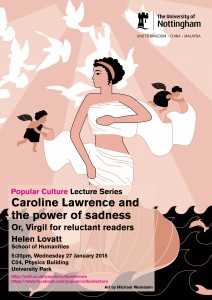
January 23, 2016, by Alex Mullen
The challenge of Virgil as children’s literature
Helen Lovatt explores Virgil as YA literature:
Caroline Lawrence has just published Queen of the Silver Arrow, an excellent retelling of Virgil’s Camilla episode, with Barrington Stoke, aimed at reluctant teenage readers. It is simply written, with a reading age of about 8, but contains challenging content more suitable for 12+. This makes it really a short, beautifully simple young adult book. This is her second adaptation of an episode from the Aeneid featuring young characters: the first was The Night Raid which I have discussed here.
It has set me thinking about the importance of young adult characters in ancient literature. YA literature often features characters who grow up over the course of the novel, leaving home and learning about themselves, finding their own place in the adult world. Achilles in Statius’ Achilleid clearly fits this description: he is just completing his education with Chiron when Thetis snatches him away to hide him from the Trojan war by dressing him as a woman on the island of Scyros. Achilles is an ephebe, an adolescent male who undergoes a sort of initiation: he is removed from his normal context, reverses expectations (in this case by dressing as a woman) but returns to society as a full man, both by recognising and appropriating the weapons offered to him and his place in the Trojan expedition, and by impregnating Deidamia.
Ancient representations of age are notoriously hard to pin down, particularly with young people. One moment Ascanius is sitting on Dido’s knee, the next he is in command of the Trojan army while Aeneas is off looking for allies. Could we read the Iliad as YA literature? Achilles is a brilliant young person who struggles against his position in society, rebels against the power structures of the Greek army, and finds himself through the death of his friend. Telemachus and Nausicaa provide a YA element in the Odyssey. The whole Argonautic myth is one long initiation rite. Many tragedies also feature young protagonists: Orestes, Electra, Ion, Iphigenia, Antigone, Hippolytus.
The problem with the Aeneid as young adult literature is that so many of the poem’s young characters come to a sticky end. It is more or less a structural feature of the poem: the deaths of Nisus and Euryalus in book 9, of Pallas in book 10, Camilla in book 11, Turnus in book 12 each form the emotional climax of their sections of the poem. The death of a young person on the cusp of adulthood is particularly powerful: parents bereaved, potential destroyed, legacy and continuity denied. They are on the point of making that successful transition, when it is all taken away. Perhaps the uncertainty of age representations increases this power.
When my ten year old daughter fractured her knee-cap last week, I was struck by how young she seemed. Normally she is capable, determined, full of energy, taking up space in the world, requiring attention, baking cakes, disagreeing with people. Suddenly she was small, quiet and sad. People inhabit their age roles inconsistently: one moment they seem much older, the next much younger. So with Pallas or Turnus in the Aeneid, or Parthenopaeus in the Thebaid: death crystallises their youth.
So how does Caroline Lawrence use this power in her re-tellings? How does she present these deaths differently for a young adult audience? To find out more, read the books (first chapter of Queen of the Silver Arrow available here), and come and hear me talk about them on Weds 27th at 5.30 in the Physics building in University Park, Nottingham.
Image credit: the Camilla passage as annotated by Caroline Lawrence, courtesy of Caroline Lawrence.
No comments yet, fill out a comment to be the first

Leave a Reply